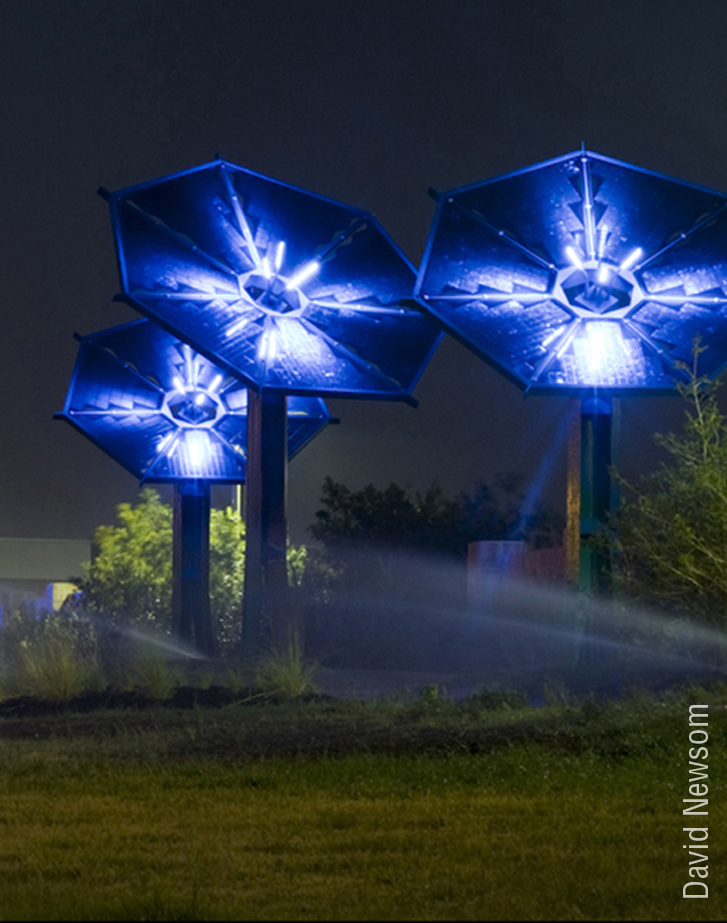How can art inspire us to reflect on – and ultimately address – our burgeoning climate and ecological crises?
Mark Dion and Alexis Rockman: Journey to Nature’s Underworld explores how two distinguished artists have tackled this question over 3 decades.
This thoughtful and thought-provoking exhibition has a threefold focus. It examines the historic origins of contemporary environmental science, how we gather scientific information. It displays intriguing samples of natural wonders discovered by scientific exploration. And it shines much-needed light on how well we heed – or fail to heed – information scientists provide about our impact on the natural world.
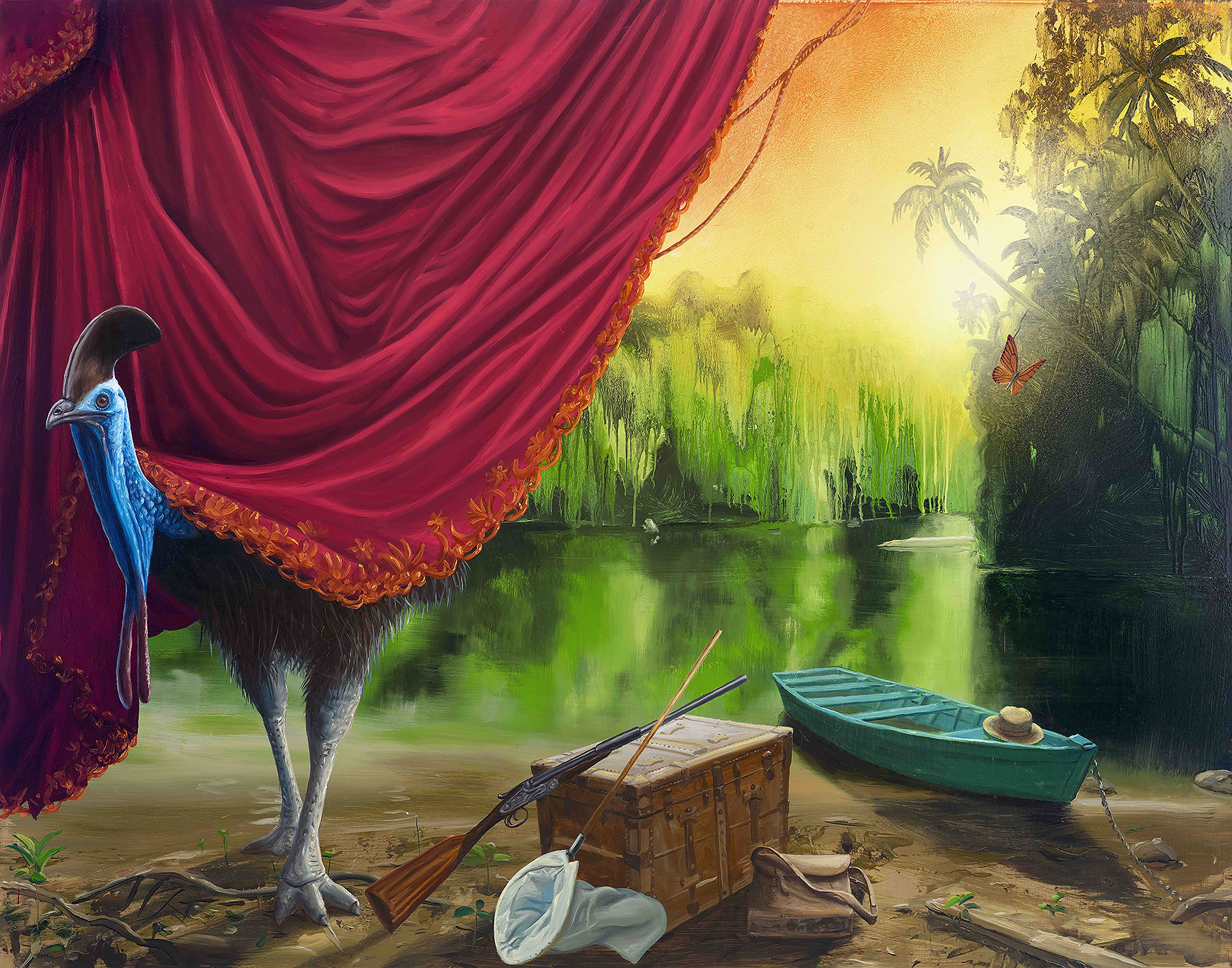
Alexis Rockman, Departure, from “Wallace’s Line” series, 2018. Oil on Dibond. 44 x 56 inches. ©2018 Alexis Rockman. Collection of Barbara and Jonathan Lee. Courtesy of American Federation of Arts and The Bruce Museum.
Alexis Rockman’s oil painting, aptly named Departure, sets the stage for this exploration. Departure highlights the career of Alfred Russell Wallace (1823-1913), an English naturalist, explorer, geographer, and illustrator. Shortly before Charles Darwin published On the Origins of Species, Wallace independently conceived of, and wrote a paper on, the theory of evolution. His paper was published alongside Darwin’s early writings on the subject. Thereafter, he and Darwin often exchanged findings and ideas.
Inspired in part by Darwin, Wallace traveled to the Malay Archipelago to collect natural history specimens. During a near decade-long exploration of the region, Wallace amassed over 125,000 specimens, including thousands of birds and 1,500 species new to science. He also identified the geographical divide – now called the “Wallace Line” – separating animals of Asian and Australian origin. He became the leading expert on the geographical distribution of animal species; today he is known as the “father of biogeography.”
Wallace was also adept at science communication. His 1869 publication – The Malay Archipelago – became one of the century’s most popular books on scientific exploration. Yet some of his most important messages went unheeded. He was one of the first scientists to recognize and call attention to the impact of human activity on the natural world. He deplored the widespread clearing of tropical rain forests for coffee cultivation, issuing early and repeated warnings that deforestation would adversely affect climate, cause soil erosion, and impoverish local communities. In one of his final publications, The World of Life (1911), he urged us to treat nature “as invested with a certain sanctity, to be used by us but not abused, and never to be recklessly destroyed or defaced.”
To depict Wallace’s wide-ranging contributions to modern science, Rockman turned for inspiration to Charles Willson Peale’s The Artist in His Museum. Peale (1741-1827), a prominent American naturalist and painter, founded the nation’s first museum, now known as the Pennsylvania Academy of Fine Arts. The Academy’s presence in Philadelphia, then the nation’s capital, afforded Peale access to America’s founding fathers, whose portraits he painted to great acclaim.
Peale also founded the Philadelphia Museum, which housed a large number of bird specimens, including many acquired from British collectors. Asked by the museum trustees to create a full-length self-portrait, he obliged with a painting honoring the museum’s collection of natural specimens as well as his own distinguished career.
In The Artist in His Museum, Peale dominates the foreground. To his right lies a specimen of a wild turkey, a species native to North America. To his left are the tools of the artist: a palette and paint brushes. As Peale dramatically lifts a curtain, he reveals the museum’s interior, where a cabinet of curiosities houses bird specimens. With outstretched palm, Peale invites the viewer to explore.
Departure employs a similar aesthetic strategy for engaging viewers. The painting’s foreground also features a curtain – an eye-catching scarlet red, rendered in fine detail and tantalizingly drawn partway back to reveal a tropical forest akin to those Wallace explored.
A lone cassowary steps out from behind the curtain, its neon blue plumage and striking anatomy drawing instant attention. Large, flightless, and highly elusive, cassowaries inhabit the tropical rainforests of Papua New Guinea, southern Indonesia and northern Australia, where they are valued cultural icons, particularly among indigenous people.
Cassowaries are keystone environmental species. They feed on the fruit of several hundred rainforest species, dispersing seeds over wide areas and thereby enhancing ecosystem stability. And cassowaries provide clues to human history. Recent evidence suggests that 18,000 years ago Pleistocene humans may have hatched and raised cassowaries – the earliest evidence of human management of avian breeding.
Yet cassowaries are also emblematic of our troubled relationship with nature. Once cassowaries reach adulthood, they have no natural enemies except humans. The birds are not without defenses: cassowaries have been known to attack – and even kill – humans when provoked. Still, vehicular collisions and habitat destruction imperil cassowaries, though some have adapted to urban environments by altering foraging behavior.
In addition to a drawn curtain, Rockman, like Peale, uses the entire foreground to spark viewer interest. Nearby Rockman’s cassowary, the tools of a 19th century naturalist – a butterfly net, knapsack, gun and treasure chest – provide a visual bridge to a boat perched on the water’s edge. A broad-brimmed hat in the bow of the boat implies a human will soon embark, piquing the viewer’s curiosity and reinforcing the invitation to join this exploration.
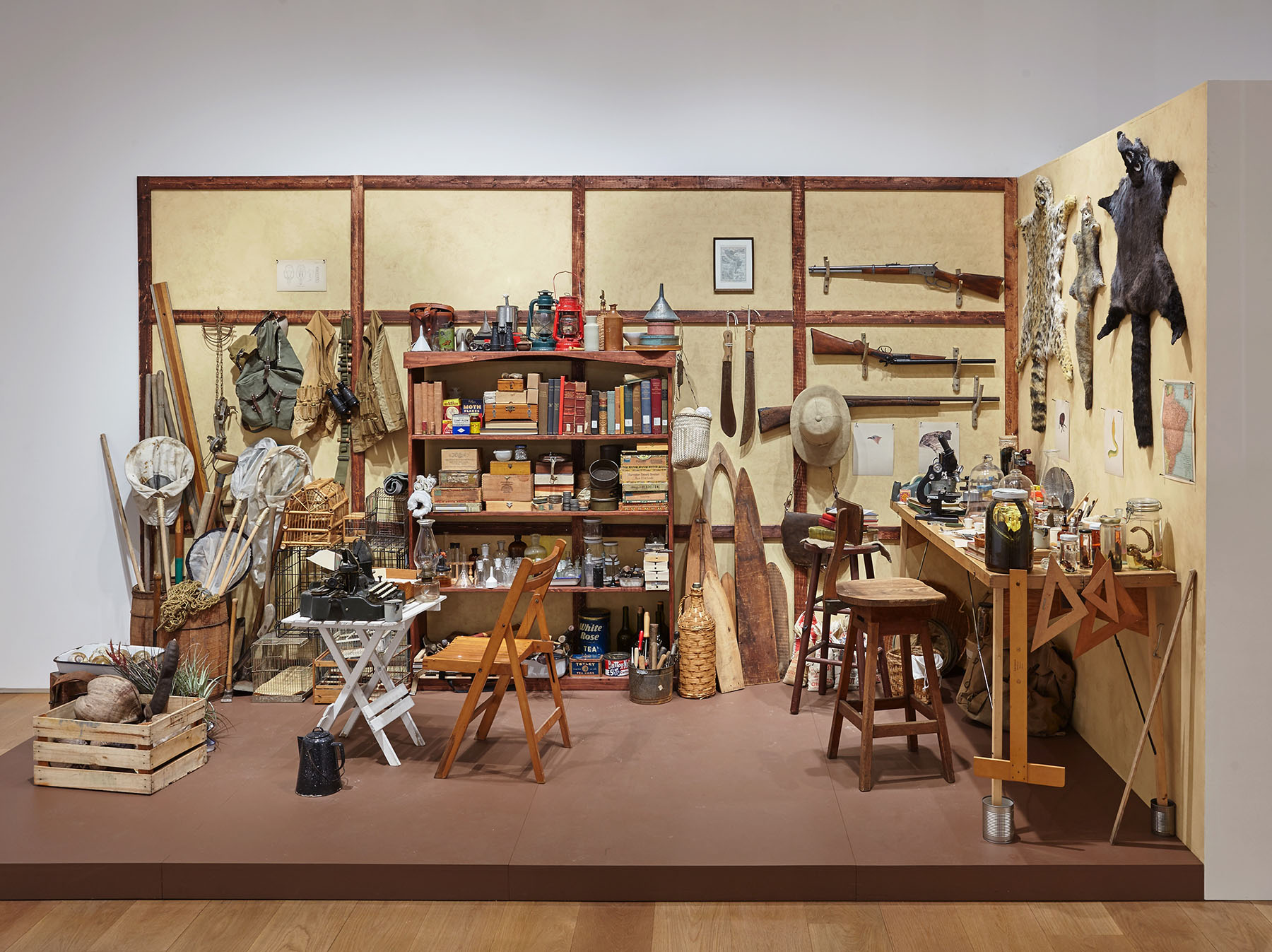
Mark Dion, Department of Tropical Research – Jungle Station, 2017. Mixed media. Dimensions variable. ©2017 Mark Dion. Courtesy of Tanya Bonakdar Gallery, American Federation of Arts, and The Bruce Museum.
Like Rockman, Mark Dion provides a historical context for examining contemporary environmental challenges. He focuses on the legacy of biologist William Beebe (1877-1962), one of America’s earliest and greatest proponents of ecology. Beebe led the Department of Tropical Research to complete over 65 expeditions to tropical forests and marine ecosystems, compiling over 2,200 field drawings.
The Department was noteworthy for pioneering research practices. Its lab was located in the rainforest, so scientists could observe organisms in their natural habitats and study how each species depended on, and influenced, its ecosystem. Women artists and scientists held lead roles. And, significantly, communicating research results to the public, as well as to other scientists, was central to the Department’s mission. Consequently, Department scientists worked closely with artists, valuing artists for their ability to convey, and engage the public with, ecological findings.
Dion’s Department of Tropical Research: Jungle Station installation drops us smack into the middle of this groundbreaking early 1900s field station. Aided by archival images and historical drawings, Dion recreated the original field lab in painstaking detail. Among the station’s accouterments are some of the very naturalist’s tools depicted by Rockman – butterfly nets, guns, a broad-brimmed hat and boxes for storing treasures.
By focusing on how we gather knowledge, Dion invites us to think critically about our scientific process and its implications for the way we regard and treat nature. One might ask, for example: would public understanding of climate change – and science in general – benefit from more frequent adoption of the Department’s model for integrating artists into scientific research teams?
The Bruce Museum is an ideal venue to explore such questions. For over 100 years, the museum has focused on the intersection of art and science, amassing a collection of 31,000 noteworthy artistic, scientific, and historical objects. For the launch of Journey to Nature’s Underworld, Dion and Rockman collaboratively mined this collection to create a modern “cabinet of curiosities.” Complete with dioramas, microscopes, personal items, artwork, photographic scrapbooks, and taxidermy and mineral specimens, this contemporary cabinet sheds light on both the historical trajectory of natural history exploration and its awe-inspiring finds.
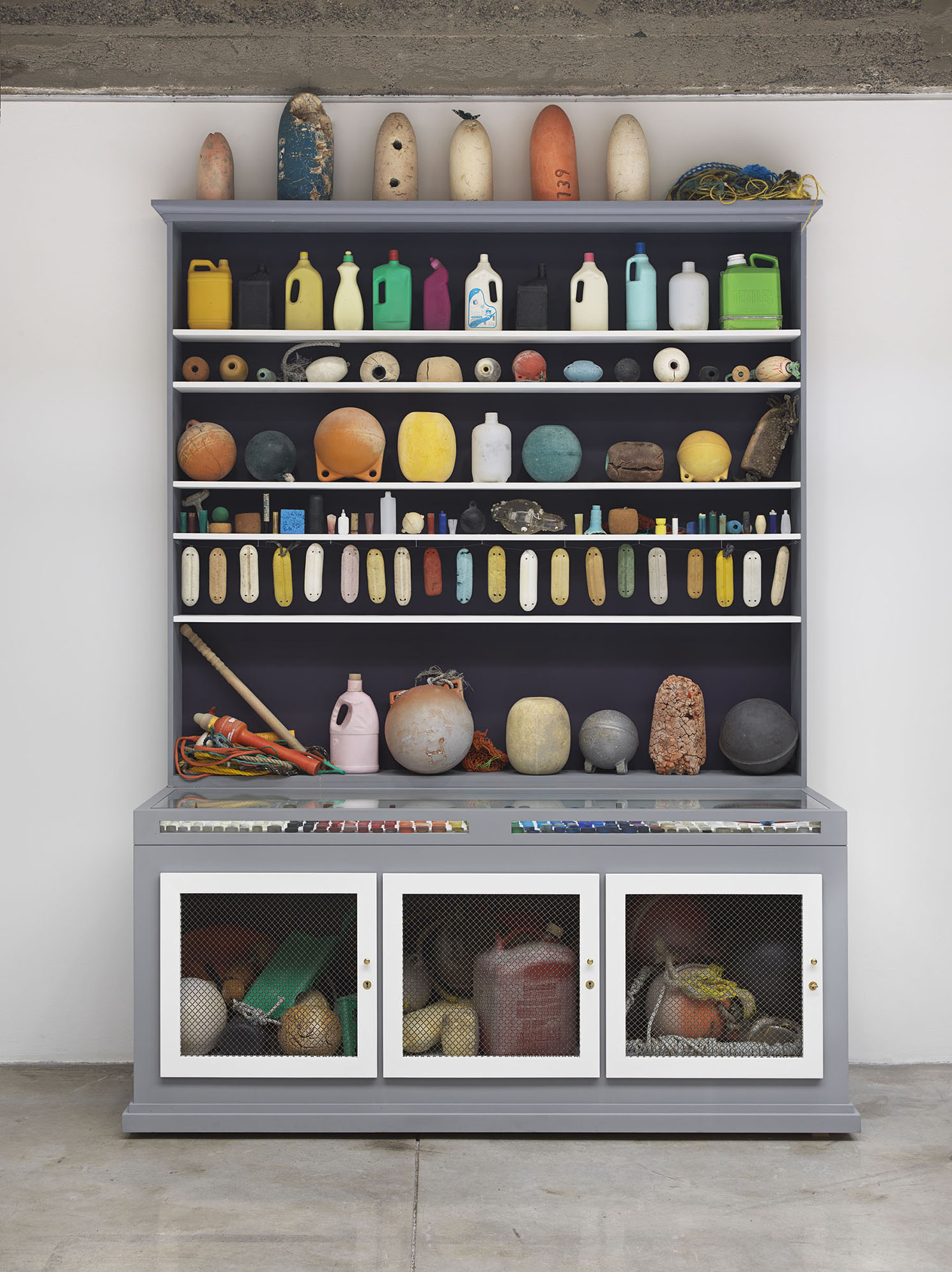
Mark Dion, Cabinet of Marine Debris, 2014. Wood and metal cabinet, marine debris, plastic, rope. 113 x 84 x 32 inches. ©2014 Mark Dion. Margulies Collection, Miami. Courtesy of American Federation of Arts and The Bruce Museum.
A cabinet of a very different sort is on display in Dion’s Cabinet of Marine Debris. To collect these “curiosities,” Dion traveled to Alaska, where the waters of the North Pacific pound the coast. The shoreline is littered with washed up debris, much of it plastic. Dion collected, cleaned and arranged the debris in a colorful, eye-catching presentation beckoning us to rethink our careless treatment of precious ocean resources.
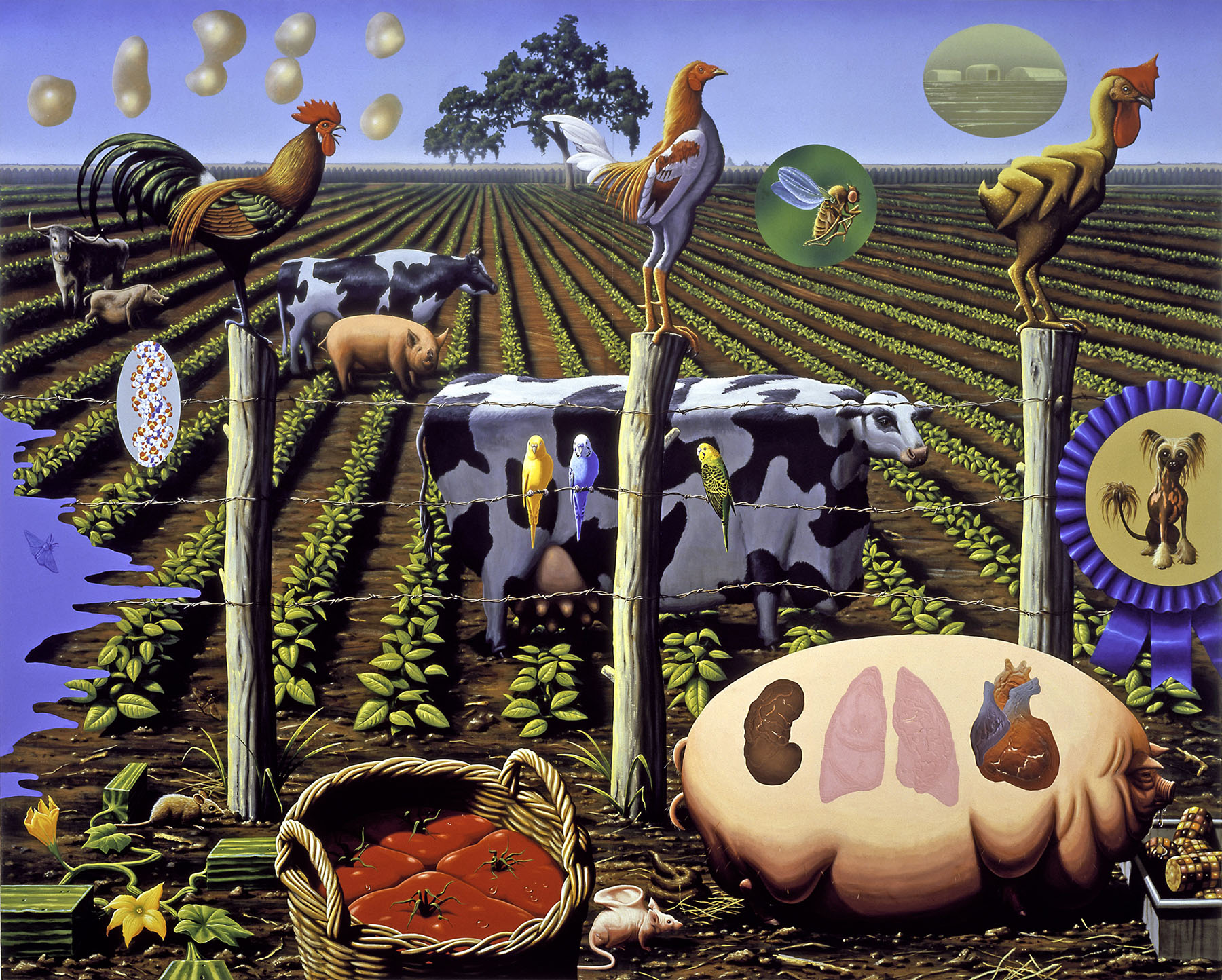
Alexis Rockman, The Farm, 2000. Oil and acrylic on wood panel. 96 x 120 inches. ©2000 Alexis Rockman. Collection of Joy of Giving Something, Inc. NY. Courtesy of American Federation of Arts and The Bruce Museum.
Rockman, too, raises deep questions for contemporary culture through this exhibition. The Farm (designed to be read from left to right) portrays a timeline of agriculture. Images of ancestral species (chicken, pig, cow, and mouse) appear on the left; their contemporary versions on the right. On the far right are “permutations of what things may look like in the future.” Where will we take biotechnology?
Journey to Natures’ Underworld is on view at The Bruce Museum through Aug. 27, 2023. The exhibition will then travel to the following venues:
- Virginia Museum of Contemporary Art, Virginia Beach, VA, Feb. 8 – June 9, 2024
- The Tang Museum at Skidmore College, Saratoga Springs, NY, July 13, 2024 – Jan. 5, 2025
- Lowe Art Museum, Univ. of Miami, Miami, FL, Feb. 13 – July 20, 2025
- Palmer Art Museum, Penn State University, PA, Aug. 23 – Dec. 7, 2025

